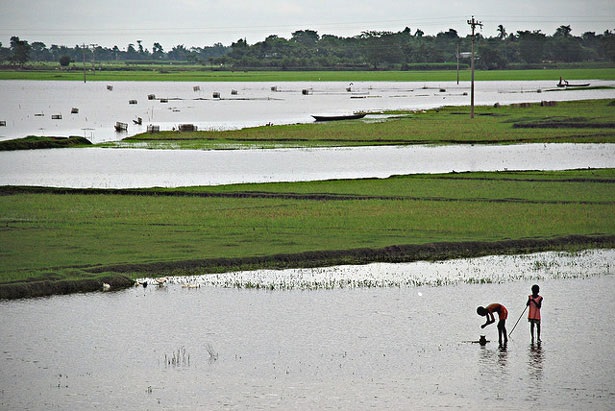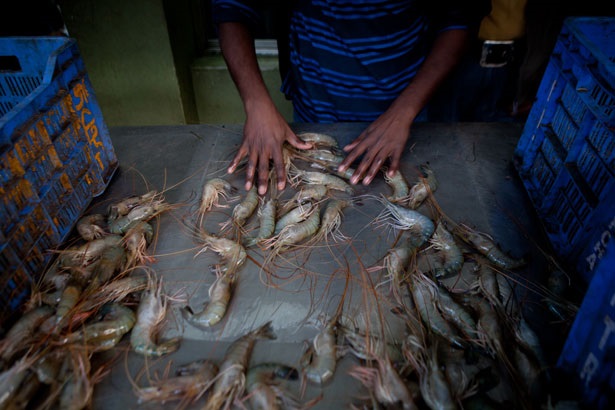-
“We Are Not Sitting Idle, We Are Fighting”: Interview With Saleemul Huq on Bangladesh’s Climate & Food Challenges
November 5, 2013 By Jacob Glass
When it comes to climate change vulnerability, it sometimes seems as if all eyes are on Bangladesh. As part of my research for a recent article exploring the rise of aquaculture in the country, I interviewed Saleemul Huq, senior fellow at the International Institute for Environment and Development in London, former executive director of the Bangladesh Center for Advanced Studies, and lead author of two chapters on adaptation and sustainable development in the IPCC’s third and fourth assessment reports. A number of his quotes made it into the final story but I wanted to provide the full transcript here as well, as his thoughts on the country’s climate-related risks, food security, and population dynamics are worth a read.
What have been the observable effects of climate change in Bangladesh?
Bangladesh has a lot of problems with salinity intrusion in the coastal areas. It has drought in the northwestern part of the country; it has floods in the central part; it suffers from cyclones; and is a rapidly urbanizing country. It’s difficult to say these are definitely happening because of climate change, but one can say that they will be exacerbated by climate change. It is early days yet, and most of the climatic impacts are in the future, rather than at the moment.
Bangladesh is one of the most densely populated countries in the world and yet relies heavily on subsistence agriculture. How has food production kept up with the growing population thus far?
The challenge is growing enough food for people to eat. Bangladesh is now celebrating its 42nd birthday as a country. In those 42 years, the population has doubled from 75 million to over 150 million.
We have fed all those people for that entire length of time. Agricultural production, particularly of rice, has grown ahead of the population in Bangladesh. This can be ascribed to our farms, to our agricultural scientists, and to the green revolution in terms of the varieties of high yielding rice that have been produced.
There have been a lot of modifications made to the rice varieties to make them more resistant and able to be used more effectively following floods, droughts, or salinity changes. Our research scientists have also developed short-duration rice strains so that if farms are flooded, they can be replanted and still produce a crop.
Do you think food diversification makes Bangladesh more resilient to environmental changes?
Absolutely. The basic strategy on food has to be diversification. Agricultural diversification is one strategy for becoming more resilient, so you don’t put all your eggs in one basket with one simple crop. A transition from a dependence on rice to more fish is needed. Fish is an important source of protein and commercial employment for people, and that is growing very, very fast.
How does aquaculture factor into Bangladesh’s production of food? What is the nature of the growing aquaculture sector?
From a nutritional aspect, fish has become a significant source of protein for the diet of almost all Bangladeshis.
First, there is the coastal belt where shrimp farming is occurring. This generally tends to be large-scale, commercial production for export. The growing of shrimp in saline conditions has become an adaptation to the condition of salinity in those areas, and has become a significant export market for the country. It has generated export earnings and employment.
The second success story is just simple freshwater aquaculture in ponds, mostly on homesteads. These are mostly small-scale operations, where people have acquired knowledge and technology for getting fingerlings [baby fish], growing fingerlings, and then selling them in the market. This has grown very fast. Bangladesh used to eat much more open-water fish from the rivers. Now we eat much more aquaculture-grown fish from the ponds.

What are some of the negative aspects related to the expansion of coastal belt, commercial-scale shrimp farms?
The main negative aspect is that in order to grow shrimp, they actually have to allow saltwater to come in. So it comes inside the shrimp farm, but it also affects the surrounding areas, and the surrounding vegetation dies.
Socially, what also happens is that the owners of these large farmers tend to be rich people coming from the city. They are not local people. They employ a few people to guard their land and bring the guards in from outside. So they don’t actually generate employment locally, and the local people’s land becomes saline and it becomes difficult for them to live and survive there. There has been quite a lot of social unrest between people who used to live in these areas and the owners of the shrimp farms.
How do population dynamics factor into food security?
Population growth has had a big role to play. In the case of Bangladesh, it is a good news story. Over the past 40 years, the population growth rate has declined from about three percent to two percent or lower.
I would say this can primarily be ascribed to girls’ education. Women and girls have been given educations and women are in the workforce. They have access to family planning and they practice family planning. In fact, one of the major attributes in terms of this success is the fact that our Imams – the preachers at the mosque – are pro-family planning and have been preaching for it.
The other factor is that the provision of mother-child healthcare has made it viable for women to have small families with the expectation that their babies will survive. One of the reasons why families would have multiple children was so that only a few would survive. Nowadays the survival rate is much higher, and they don’t have to have as many babies.
So all of these factors have brought down the fertility rate and the population growth rate in Bangladesh very significantly, without coercion, and in a predominantly Muslim country. It’s an amazing phenomenon and has not been duplicated anywhere else in the world.
What are some of your hopes and fears, looking ahead to Bangladesh’s environmental challenges in the years ahead?
The fear is that climate change will exacerbate already existing risks for food shortages, damage crops, and increase rural to urban migration. These are trends that are already happening and are likely to be adversely affected by climate change
The other side of that coin is more hopeful. As a country, Bangladesh is very aware of this problem. From the government, down to civil society, to our researchers, we are now taking steps to deal with it. We are not sitting idle. We are fighting. We are coming up with solutions. Bangladeshis in general are a very, very resilient people, so my hope and faith lies in that resilience and our ability to overcome adversity.
That is the story here – the resilience, not the vulnerability. Bangladeshis are vulnerable, but they are also extremely resilient, and that resilience is what will help us tackle these adverse conditions that climate change is bringing to us and overcome them in the long run.
Photo Credit: “Deluge,” courtesy of flickr user Amir Jina; “Shrimp seller in Khulna, Bangladesh,” courtesy of WorldFish.
Topics: adaptation, agriculture, Bangladesh, Beat on the Ground, climate change, conflict, demography, development, education, environment, environmental security, family planning, featured, flooding, food security, livelihoods, migration, natural resources, population, risk and resilience, urbanization, water
 A Publication of the Stimson Center.
A Publication of the Stimson Center.








